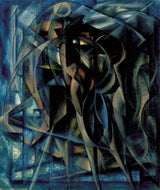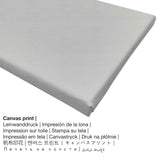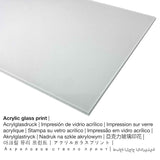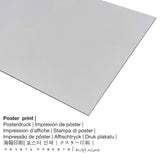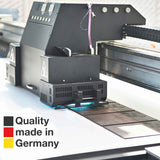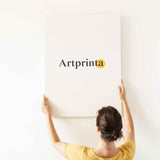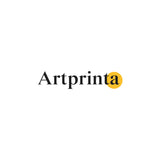Benjamin F. Berlin, 1929 - Ọnụ ọgụgụ - ọmarịcha nka nka
Ụtụ gụnyere. Mbupu gbakọrọ na ndenye ọpụpụ.
Ihe osise a bụ nwoke na-ese ihe Benjamin F. Berlin. Nke kariri 90 afọ mbụ e mere na size 32 1/4 x 27 3/8 na (81,92 x 69,53 cm) e jikwa nkà na-ese ihe mmanụ na kwaaji. Nke a na-arụ ọrụ nka Nleta akụkụ nke dijitalụ art collection nke Ebe ngosi nka nke Los Angeles County, nke bụ ụlọ ngosi nka nka kachasị na ọdịda anyanwụ United States, yana nchịkọta ihe karịrị 142.000 ihe na-enye ìhè afọ 6.000 nke ngosipụta nka n'ofe ụwa. Site n'ikike nke Ụlọ ihe ngosi nka nke Los Angeles County (www.lacma.org) (public domain).: . Besides, the alignment of the digital reproduction is in portrait format and has a side ratio of 1: 1.2, nke pụtara na ogologo bụ 20% mkpụmkpụ karịa obosara.
Họrọ ụdị ebipụta nka kacha amasị gị
Maka mbipụta nka ọ bụla dị mma anyị na-enye nha na ihe dị iche iche. Anyị na-ahapụ gị ka ịhọrọ nha na akụrụngwa ọkacha mmasị gị n'etiti nhọrọ nhazi ngwaahịa ndị a:
- Aluminom ihe eji eme ihe: An Aluminium Dibond print is a print with a true depth effect, which creates a contemporary look by having a non-reflective surface structure. The Direct Print on Aluminum Dibond is your best start to reproductions with aluminum. The bright and white parts of the original artpiece shimmer with a silk gloss, however without any glare. The colors of the print are luminous, the details of the print appear crisp and clear, and the print has a a matte appearance you can literally feel. This direct UV print on aluminium is the most popular entry-level product and is a contemporary way to showcase art, as it draws attention on the replica of the artwork.
- Mpempe akwụkwọ mmado ebipụtara na akwa akwa: A poster print is a UV printed sheet of canvas with a slightly rough finish on the surface. It is particularly suited for placing your art copy using a custom-made frame. Please bear in mind, that depending on the size of the canvas poster print we add a white margin between 2-6cm round about the print, which facilitates the framing.
- Bipụta na enyo acrylic: The print on acrylic glass, often denoted as a print on plexiglass, will transform your favorite original work of art into stunning wall décor and offers a viable alternative to aluminium and canvas art prints. The artwork will be manufactured with the help of modern UV direct print machines. The image effect of this are vivid and sharp colors. With an acrylic glass art print contrasts and also small color details become recognizeable thanks to the subtle gradation.
- Mbipụta kwaaji: A UV printed canvas mounted on a wood stretcher frame. A canvas generates the typical effect of three dimensionality. Canvas Prints have the advantage of being low in weight, meaning that it is quite simple to hang your Canvas print without the use of any wall-mounts. Canvas prints are suited for all types of walls.
Disclaimer: We do what we can in order to depict the art products as closely as it is possible and to demonstrate them visually on the respective product detail pages. Nevertheless, the tone of the printing material and the print result might vary marginally from the presentation on the screen. Depending on the screen settings and the nature of the surface, not all color pigments can be printed one hundret percent realistically. In view of the fact that all our art prints are processed and printed manually, there might also be minor differences in the motif's size and exact position.
Banyere edemede a
| Nkewa ngwaahịa: | mmepụta nka |
| Usoro mmeghari: | dijitalụ mmeputakwa |
| Produzọ mmepụta: | Mbipụta UV ozugbo |
| Production: | German mmepụta |
| Ụdị ngwaahịa: | na mmepụta ihe |
| Eji ngwaahịa emebere: | mgbidi mgbidi, nka mgbidi |
| Ndepụta: | usoro eserese |
| Oke akụkụ: | ogologo ruo obosara 1: 1.2 |
| Nsonaazụ: | ogologo bụ 20% mkpụmkpụ karịa obosara |
| Nhọrọ akwa: | ígwè ebipụta (aluminium dibond), acrylic glass print (nwere ezigbo mkpuchi iko), mbipụta akwụkwọ mmado (akwụkwọ kwaaji), akwụkwọ akwa akwa. |
| Canvas dị n'elu ihe nrịbama (mbipụta kanvas) nha dị iche iche: | 50x60cm - 20x24", 100x120cm - 39x47" |
| Mbipụta iko acrylic (nwere ezigbo mkpuchi iko) nhọrọ nha: | 50x60cm - 20x24", 100x120cm - 39x47" |
| Mpempe akwụkwọ mmado (akwụkwọ kwaaji) nha: | 50x60cm - 20x24", 100x120cm - 39x47" |
| Mbipụta nke aluminom (ihe aluminom): | 50x60cm - 20x24", 100x120cm - 39x47" |
| Nhazi mbipụta nka: | mbipụta nka na-enweghị isi |
Data nka ahaziri
| Aha nke ihe nka: | "Figures" |
| Nhazi: | sere |
| Okwu nche anwụ: | nkà nke oge a |
| oge: | 20th narị afọ |
| Emepụtara na: | 1929 |
| Ogologo afọ nka nka: | ihe karịrị 90 afọ |
| Agba na: | mmanụ na kwaaji |
| Nha izizi: | 32 1/4 x 27 3/8 na (81,92 x 69,53 cm) |
| Egosiputara na: | Ebe ngosi nka nke Los Angeles County |
| Ebe ngosi nka: | Los Angeles, California, Njikota Obodo Amerika |
| Weebụsaịtị nke ihe ngosi nka: | www.lacma.org |
| Licensedị ikike: | ngalaba ọha |
| Site n'aka: | Ụlọ ihe ngosi nka nke Los Angeles County (www.lacma.org) |
Tebụl nchịkọta ihe nkiri
| Ihe nkiri: | Benjamin F. Berlin |
| Gender: | nwoke |
| Ọrụ: | onye na-ese ihe |
| nhazi ọkwa: | omenkà nke oge a |
© Nchekwa ikike nwebisiinka, Artprinta.com (Artprinta)
(© - site na Los Angeles County Museum of Art - Ebe ngosi nka nke Los Angeles County)
Berlin’s turn to modernism was supposedly initiated by his reading of Jerome Eddy’s notable book Cubists and Post-Impressionism (1914), and his earliest abstractions are indebted to cubism. Although Berlin probably never visited France, by the 1920s cubism was well known in Los Angeles and he would have been aware of it. In this painting the figures are fused with the surrounding environment in a configuration of overlapping and intersecting faceted planes and ray lines, standard cubist devices. During the 1920s, when this canvas may have been painted, STANTON MACDONALDWRIGHT was the dominant force in Los Angeles’s modernist circles. His art, although exhibiting more arabesque lines, may have influenced Berlin’s treatment of the figure, especially in his use of delicate, translucent planes. The cubist art of Lorser Feitelson, who became a major progressive force in Los Angeles after his move to the West Coast in 1927, also may have served as a model for Berlin. A painting that may have directly inspired Figures is Nude Descending a Staircase (No. 2), 1912 (Philadelphia Museum of Art), by Marcel Duchamp (1887-1968). Duchamp’s often reproduced painting was a notorious modernist work, and it is likely that Berlin became acquainted with it through the collector Walter Arensberg, who had settled in Hollywood in the 1920s and always opened his home to artists. Arensberg did not acquire the painting until 1930, but before that time he proudly displayed a color reproduction of it. As in Duchamp’s painting, Berlin’s cubist analysis of movement results in an allover composition of intersecting planes and diagonal lines colored in a somber dominant hue. The dark lines are in blue with brighter, warm colors brushed in to create a translucent effect. Figures may have been one of the paintings, as was Rhythmic Forms (unlocated), in Berlin’s 1924 exhibition at the Potboiler, for in an article commenting on the show, Berlin was praised for being one of the first to attempt the depiction of the fourth dimension.

